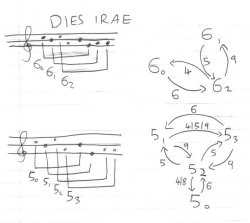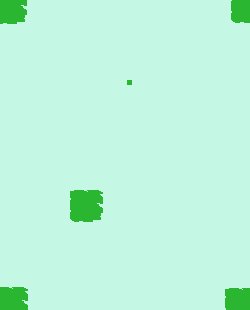Hmm, so in the interest of subscribing to this mathematical carnival what’s doing the rounds now, I’m writing something specifically mathematical in nature, my favourite elementary derivation. I’m trying to make it understandable and brief – if anyone is having trouble following, I can help in the comments.
Okay, so lets say we’re hearing a signal given by f(t); let’s assume it’s periodic. Now, to monitor what we hear, we have to view this as a sum of sine waves
f=a*sin(t)+b*sin(2t)+c*sin(3t)+ …
so a,b,c represent the frequencies we hear of frequency 1,2,3, etc, and the bigger the coefficient the bigger the amplitude.
Lets look at two really simple sounds, pure sine waves of different frequencies sin(at), and sin(bt). SO, they each have exactly one frequency present.
Now, so what if there were some non-linearity of our hearing system. That is what if, when someone plays f=sin(at)+sin(bt), we don’t actually hear this, but rather something more complicated.
So, the simplest way of such a thing being non-trivial is to introduce a quadratic non-linearity (ignoring coefficients…we’re thinking that because “all” functions can be taylor expanded as f(t)+f(t)2/2+f(t)3/3!+…, the next best thing to having just f(t) is to having the first two terms).
So, anyway, now when someone plays a signal f(t), we don’t hear f(t), but rather f(t)+f(t)2
So, what results from this? Well, we have to break down f(t)+f(t)2 to being a sum of sine waves first.
f(t)+f(t)2=sin(at)+sin(bt)+ (sin(at)+sin(bt))2
=sin(at)+sin(bt)+sin(at)2+sin(bt)2+2sin(at)sin(bt)
looking up trig tables and decomposing further we get (ignoring coefficients)
=sin(at)+sin(bt)+cos(2a)+cos(2b)+sin(a+b)+sin(a-b)
Ah, so look at this. We might be led to deduce from this that, if non-linearities were present, when someone plays two frequencies at the time, we will also perceive sounds playing at double either frequency, their sum, and their difference.
Now, the multiples of a and b can be reasonably expected to be masked by overtones (though it is possible to bring them out), but the difference (and, to a lesser extent, the sum), on the other hand, can be controlled very easily, just by bringing the two source sounds closer together or further apart. And, indeed, we can quite easily hear them.* Which is darnedly neat.
I like this calculation so very, very much because it’s surprisingly fruitful; whenever I feel like I’m loosing my faith in the power of Taylor expansions, I go through this derivation again.
The phenomenon was first noted by Tartini, the derivation was by Helmholtz, and these extra tones are sometimes called Tartini tones or, more commonly combination tones.
What’s also interesting, by the by, is that these effects are actually quadratic: I remember, the first time I heard an example (they can be found on the interweb quite easily, here for instance), I was listening to them with earphones, and the strength of the combination tone totally overwhelmed the two base ones. But, when I played it on speakers, it was much weaker relative to these tones, and if I went too far away, I couldn’t hear it at all.
*okay; this is a lie, actually the third order terms are the easiest to hear, corresponding to things like 2a-b…and there’s an explanation for this (check out Dave Benson’s notes if you want to know more).









